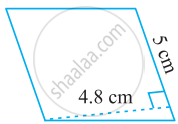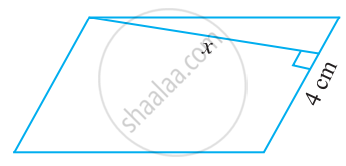Advertisements
Advertisements
Question
In a parallelogram the base is three times its height. If the height is 8 cm then the area is
Options
64 sq.cm
192 sq.cm
32 sq.cm
72 sq.cm
Solution
192 sq.cm
Explanation;
Hint: Given b = 3 × h, h = 8 cm
Area = b × h
= 3h × 8
= 3 × 8 × 8
= 192 cm2
APPEARS IN
RELATED QUESTIONS
Find the area of the following parallelogram:

PQRS is a parallelogram (see the given figure). QM is the height from Q to SR and QN is the height from Q to PS. If SR = 12 cm and QM = 7.6 cm. Find:
- the area of the parallelogram PQRS
- QN, if PS = 8 cm

The adjacent sides of a parallelogram are 21 cm and 28 cm. If it's one diagonal is 35 cm; find the area of the parallelogram.
Find the height ‘x’ if the area of the parallelogram is 24 cm2 and the base is 4 cm.

Find the missing values.
| Base | Height | Area |
| 8 cm | 56 sq.m |
A ground is in the shape of parallelogram. The height of the parallelogram is 14 metres and the corresponding base is 8 metres longer than its height. Find the cost of levelling the ground at the rate of ₹ 15 per sq.m
A square and a parallelogram have the same area. If the side of the square is 48 m and the height of the parallelogram is 18 m. Find the length of the base of the parallelogram
Find the missing value:
| Base | Height | Area of parallelogram |
| 15.6 cm | ______ | 16.38 cm2 |
Altitudes MN and MO of parallelogram MGHK are 8 cm and 4 cm long respectively in the below figure. One side GH is 6 cm long. Find the perimeter of MGHK.

ABCD is a parallelogram in which AE is perpendicular to CD as shown in the given figure. Also, AC = 5 cm, DE = 4 cm and area of ΔAED = 6 cm2. Find the perimeter and area of parallelogram ABCD.
